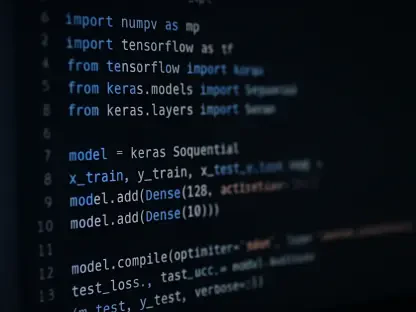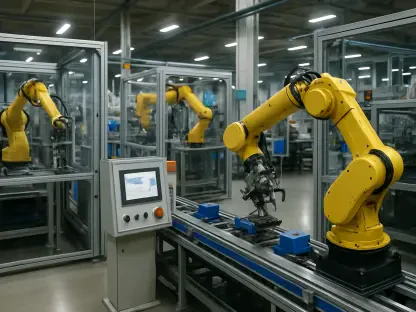Setting the Stage for a Transformative Yet Risky Landscape
Imagine a market where investments in a single technology sector surpass the GDP of entire nations, where a company’s valuation skyrockets to over $4 trillion, and where the promise of machines thinking like humans fuels both fascination and fear. This is the reality of the generative AI market in 2025, a space brimming with potential but shadowed by whispers of speculative excess. The stakes are high as capital expenditures on data centers and AI infrastructure reshape economic landscapes, while developers and businesses grapple with the practical utility of tools like large language models (LLMs). This analysis aims to dissect the current trends, financial dynamics, and technological realities of generative AI, offering a clear-eyed forecast of whether this boom can sustain its momentum or if a dramatic correction looms on the horizon. The importance of this examination lies in guiding stakeholders through a market that could redefine industries—or repeat the painful lessons of past tech bubbles.
Diving Deep into Market Dynamics and Projections
Financial Surge: Unprecedented Investments and Concentrated Risks
The generative AI market stands out for its staggering financial scale, with capital expenditures on infrastructure acting as a significant economic driver. Data center build-outs alone are a cornerstone of this growth, contributing an estimated 1.2% to U.S. GDP, akin to major public works projects of the past. A single player dominates this space, with a market capitalization exceeding $4 trillion and representing over 7% of the S&P 500’s value, highlighting a concentration of power that poses systemic risks. While some financial analysts point to robust profit margins from leading tech conglomerates as evidence of market stability, others caution that such heavy reliance on a few key entities could spell trouble if investor sentiment shifts. The sheer volume of investment signals confidence, but it also raises questions about whether returns will match the hype in the long run.
Moving beyond individual players, the broader economic impact of AI investments cannot be ignored. The influx of capital into hardware, software, and cloud services has spurred job creation and innovation across multiple sectors, from semiconductors to cybersecurity. However, the pace of spending—often outstripping measurable outcomes in productivity—suggests a potential mismatch between expectation and reality. Market watchers are keenly observing whether this financial fervor will translate into sustainable growth or if it mirrors the overzealous investments of historical tech frenzies, where enthusiasm often outpaced fundamentals.
Technological Realities: Promises Versus Limitations
Shifting focus to the technological underpinnings, generative AI, particularly LLMs, drives much of the market’s excitement with capabilities in content creation and automation. These models have captured attention for their ability to mimic human language, positioning them as tools for everything from customer service to creative writing. Yet, beneath the surface, significant constraints temper optimism, as research consistently shows that such systems lack genuine reasoning or the ability to generalize beyond their training data. This gap between perceived intelligence and actual functionality challenges the notion that scaling computational resources alone will unlock transformative breakthroughs.
Further scrutiny reveals that the market’s reliance on current AI architectures may be a double-edged sword. Industry critiques emphasize that without fundamental redesigns—potentially through approaches like neurosymbolic systems that blend statistical learning with logical reasoning—the path to artificial general intelligence (AGI) remains elusive. For businesses banking on AI as a game-changer, these technological ceilings suggest a need for tempered expectations and diversified strategies. The market must pivot toward innovation that addresses these core shortcomings if it hopes to maintain investor confidence over the next few years.
Practical Adoption: Developer Feedback and Market Penetration
On the ground, software developers provide a critical lens into generative AI’s market penetration, particularly through applications like code generation, often hailed as a flagship use case. These tools have streamlined repetitive tasks, boosting efficiency for many in the tech workforce, yet the feedback is far from universally glowing. Frequent errors, inconsistent outputs, and the need for extensive debugging often offset initial time savings, painting a picture of a market still grappling with reliability issues. This pragmatic view underscores a disconnect between marketing promises and day-to-day utility, influencing adoption rates across enterprises.
Regional disparities also shape the market’s trajectory, as access to cutting-edge AI tools varies widely between established tech hubs and emerging economies. In areas with robust infrastructure, adoption is accelerating, while others lag due to cost barriers and limited technical expertise. This uneven distribution could fragment the market, creating pockets of rapid growth alongside zones of stagnation. Companies looking to capitalize on AI must navigate these adoption challenges, balancing the allure of innovation with the reality of inconsistent performance as reported by end-users.
Future Outlook: Growth Pathways and Potential Pitfalls
Looking ahead, the generative AI market is at a crossroads, with emerging trends offering both hope and caution for investors and innovators alike. Concepts like agentic AI, which focuses on autonomous task execution, and hybrid models integrating diverse methodologies, signal potential pathways to overcome existing limitations. Projections indicate that targeted investments in these areas could drive significant advancements by 2027, provided regulatory and ethical hurdles around data privacy are addressed. The market’s ability to adapt to such evolving frameworks will likely determine whether it sustains its upward trajectory.
However, economic headwinds and speculative risks cast a shadow over these optimistic forecasts. The sustainability of massive infrastructure spending remains under scrutiny, especially if tangible returns fail to materialize at the expected pace. Historical analogies to past tech bubbles suggest that a market correction could prune overhyped segments while leaving resilient players to integrate AI into lasting solutions. Analysts anticipate that even in a downturn scenario, foundational progress in AI applications will endure, reshaping industries over the long term, albeit with a more measured pace of growth.
Reflecting on Insights and Charting Strategic Moves
Looking back, this analysis of the generative AI market uncovered a landscape defined by extraordinary financial commitments, technological promise, and practical challenges that shaped its volatile trajectory. The concentration of market power in a few dominant players raised red flags about systemic vulnerabilities, while the limitations of current AI models underscored the need for innovation beyond mere scale. Developer experiences further grounded the discussion, revealing a market where utility often clashed with inconsistency, tempering the initial wave of enthusiasm.
For stakeholders, the path forward demands strategic caution paired with proactive adaptation. Businesses are encouraged to prioritize practical AI applications over speculative AGI narratives, diversifying investments to mitigate risks tied to market concentration. Developers and professionals need to focus on skill-building in AI integration while maintaining a critical eye on overhyped claims. Meanwhile, policymakers must consider frameworks that balance innovation with ethical oversight, ensuring data privacy does not become a casualty of growth. By aligning strategies with these realities, the market’s key players can navigate potential turbulence, positioning themselves to harness AI’s enduring potential even amidst uncertainty.









